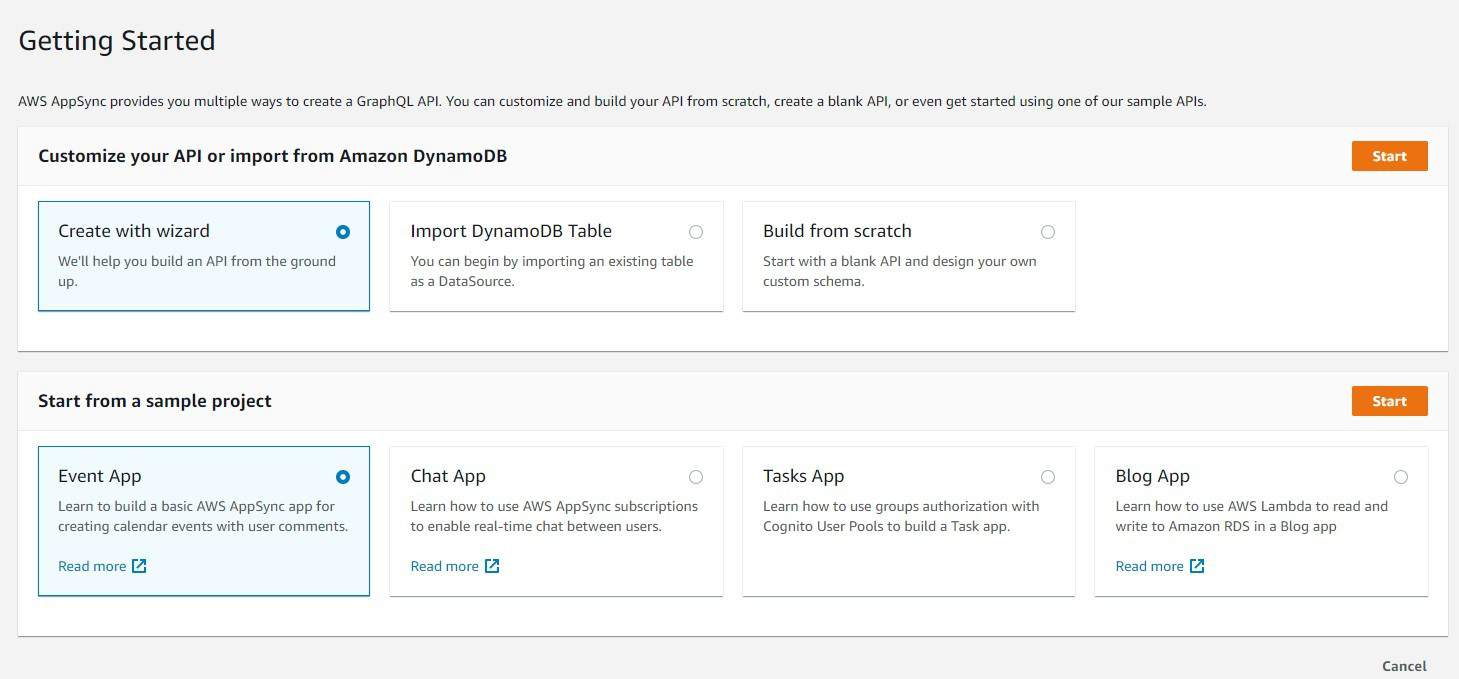1. 简介
本文将介绍如何在 Spring Boot 项目中集成 AWS AppSync。AWS AppSync 是一项完全托管的企业级 GraphQL 服务,支持实时数据同步和离线编程能力,非常适合构建现代移动和 Web 应用。
相比自建 GraphQL 服务,AppSync 省去了服务器运维、认证授权、订阅推送等复杂环节,开箱即用,尤其适合快速验证产品原型或中小型项目。
2. 配置 AWS AppSync
首先你需要一个有效的 AWS 账号(可注册免费套餐)。登录 AWS 控制台后,搜索 “AppSync” 服务,进入后点击 Getting Started with AppSync 开始创建你的第一个 API。
2.1 创建 AppSync API
按照官方 快速入门指南,选择使用示例项目中的 Event App 模板。点击 Start 后,为你的应用命名并创建:
创建完成后会跳转到 AppSync 控制台,你可以在这里查看自动生成的 GraphQL 模型、接口、数据源等信息。
2.2 GraphQL Event 模型解析
GraphQL 使用 Schema 定义客户端可访问的数据结构以及与服务端交互的方式。Schema 包含查询(Query)、变更(Mutation)和各种自定义类型。
我们来看一下 AppSync 自动生成的 Event 模型片段:
type Event {
id: ID!
name: String
where: String
when: String
description: String
# Paginate through all comments belonging to an individual post.
comments(limit: Int, nextToken: String): CommentConnection
}
✅ Event 是一个对象类型,包含若干字段。
⚠️ 注意 id: ID! 中的感叹号 !,表示该字段为非空(required),客户端查询时必须返回。
✅ comments 字段返回的是一个连接类型(Connection),用于支持分页查询,这是 GraphQL 推荐的分页模式。
这个简单的模型已经涵盖了基本的增删改查需求,足够我们后续测试使用。
3. Spring Boot 客户端集成
接下来我们在 Spring Boot 项目中调用 AppSync 提供的 GraphQL 接口。
3.1 Maven 依赖
我们使用 Spring WebFlux 提供的 WebClient 作为 HTTP 客户端,相比传统的 RestTemplate,它更现代、支持响应式编程,也更适合处理 GraphQL 的 POST 请求。
<dependency>
<groupId>org.springframework.boot</groupId>
<artifactId>spring-boot-starter-webflux</artifactId>
</dependency>
💡 提示:如果你项目中已引入
spring-boot-starter-web,建议统一使用 WebFlux 或传统 Servlet 栈,避免混合编程模型带来的复杂性。
3.2 构建 GraphQL 客户端
AppSync 的所有请求都通过同一个接口(endpoint) /graphql 发起,使用 API Key 进行认证。
我们使用 WebClient 构建基础请求结构:
WebClient.RequestBodySpec requestBodySpec = WebClient
.builder()
.baseUrl("https://your-api-id.appsync-api.us-east-1.amazonaws.com/graphql")
.defaultHeader("x-api-key", "da2-xxxxxxxxxxxxxxxxxxxxxx") // 替换为你实际的 API Key
.build()
.method(HttpMethod.POST)
.uri("/graphql");
✅ baseUrl 填写 AppSync 控制台中显示的 GraphQL endpoint 地址。
✅ x-api-key 是 AppSync 认证的关键,必须携带,否则会返回 401 错误。
⚠️ API Key 有有效期(默认 365 天),生产环境建议结合 AWS IAM 或 Cognito 实现更安全的认证方式。
4. 操作 GraphQL 类型
4.1 查询(Query)
GraphQL 查询通过 POST 请求体中的 query 字段传递。我们构造一个获取所有事件的查询:
Map<String, Object> requestBody = new HashMap<>();
requestBody.put("query", "query ListEvents {"
+ " listEvents {"
+ " items {"
+ " id"
+ " name"
+ " where"
+ " when"
+ " description"
+ " }"
+ " }"
+ "}");
然后通过 WebClient 发起请求并获取响应:
WebClient.ResponseSpec response = requestBodySpec
.body(BodyInserters.fromValue(requestBody))
.accept(MediaType.APPLICATION_JSON, MediaType.APPLICATION_XML)
.acceptCharset(StandardCharsets.UTF_8)
.retrieve();
最终将响应体转为字符串进行断言:
String bodyString = response.bodyToMono(String.class).block();
assertNotNull(bodyString);
assertTrue(bodyString.contains("My First Event"));
⚠️ 实际项目中不建议直接处理原始 JSON 字符串,应定义 POJO 并反序列化。后续可通过 Jackson 配合
@JsonProperty映射字段。
4.2 变更(Mutation)
GraphQL 使用 Mutation 实现数据的增、删、改操作。语法结构与 Query 类似,只是关键字不同。
下面是一个创建新事件的 Mutation 示例:
String queryString = "mutation add {"
+ " createEvent("
+ " name:\"My added GraphQL event\""
+ " where:\"Day 2\""
+ " when:\"Saturday night\""
+ " description:\"Studying GraphQL\""
+ " ){"
+ " id"
+ " name"
+ " description"
+ " }"
+ "}";
requestBody.put("query", queryString);
✅ AppSync 的强大之处在于:一个接口地址支持整个 Schema 的所有 CRUD 操作。
✅ 无论是查询、创建、更新还是删除,都可以复用同一个 WebClient 实例,只需更改请求体中的 query 内容即可。
✅ 响应结果会根据你请求的字段返回对应数据,真正做到“按需索取”。
验证结果:
assertNotNull(bodyString);
assertTrue(bodyString.contains("My added GraphQL event"));
assertFalse(bodyString.contains("where")); // 因为返回字段中未包含 where
5. 总结
本文演示了如何快速搭建 AWS AppSync GraphQL 服务,并通过 Spring Boot 的 WebClient 实现对接。整个过程无需管理服务器,也不用写后端业务逻辑,非常适合 MVP 验证或前后端分离项目。
✅ 优势总结:
- 全托管服务,免运维
- 支持实时订阅(WebSocket)
- 内置离线同步能力
- 单一接口支持全量操作
❌ 注意事项:
- API Key 不适合生产环境长期使用
- 成本随请求量增长,需关注计费模型
- 调试时建议开启 AppSync 的日志和监控
🔗 更多进阶内容可参考官方文档:AWS AppSync Developer Guide
💡 示例代码已上传至 GitHub:https://github.com/tech-lead-tutorial/aws-appsync-springboot-demo
